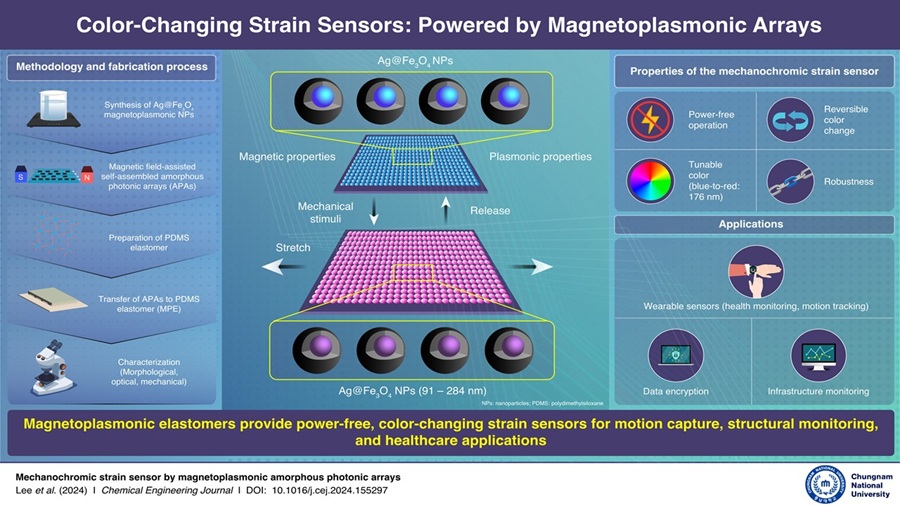Power-Free Color-Changing Strain Sensor Enables Applications in Health Monitoring
|
By HospiMedica International staff writers Posted on 25 Dec 2024 |

Wearable devices and smart sensors are revolutionizing health and activity monitoring, enabling functions like heart rate tracking and body movement detection. However, conventional tools like stethoscopes and fitness trackers face several challenges. These include requiring user training, struggling with capturing subtle signals accurately, and being limited in flexibility and ease of use. These limitations hinder their effectiveness for tasks that require precision, adaptability, and ease of use, such as real-time health monitoring or motion tracking. To overcome these challenges, researchers have created an advanced mechanochromic strain sensor that changes color in response to mechanical stress. Their study, featured in the Chemical Engineering Journal, demonstrates the sensor’s potential as a versatile, power-free tool. This device integrates flexible polymers with innovative nanoparticles, offering a dependable, user-friendly solution for tracking health and activity in real time.
The sensor was developed by researchers at Chungnam National University (Daejeon, Korea) using magnetoplasmonic nanoparticles (MagPlas NPs). These nanoparticles feature a silver core (60 nm) and an iron oxide (Fe₃O₄) shell, which allow them to interact with light and magnetic fields. They are produced using solvothermal synthesis, a technique that controls chemical reactions at high temperatures to produce uniform particles in large quantities. A key design element of the sensor is the arrangement of the MagPlas NPs. When a liquid containing these particles is dropped onto a porous material, such as filter paper or a polyethersulfone (PES) membrane, and exposed to a magnetic field, the particles align tightly on the surface rather than sinking into the pores. This creates a uniform layer known as an amorphous photonic array (APA), which produces stable, bright colors that remain consistent when viewed from different angles.
These APAs are then transferred onto a flexible, stretchable material, polydimethylsiloxane (PDMS), enabling the sensor to change color when subjected to mechanical stress. By adjusting the nanoparticle size between 91 and 284 nanometers, the researchers controlled the sensor's color changes. The most noticeable shift, from blue to red, occurred when the particles were 176 nanometers in size. These color changes are fully reversible and stable, even after repeated stretching, ensuring durability and reliability. The sensor holds potential for a wide range of applications. In healthcare, it could serve as a wearable device to track movements such as bending the knee, turning the neck, or even subtle motions like heartbeats or eye twitches.
Latest Critical Care News
- Novel Cannula Delivery System Enables Targeted Delivery of Imaging Agents and Drugs
- Ingestible Smart Capsule for Chemical Sensing in the Gut Moves Closer to Market
- Novel Intrabronchial Method Delivers Cell Therapies in Critically Ill Patients on External Lung Support
- Generative AI Technology Detects Heart Disease Earlier Than Conventional Methods
- Wearable Technology Predicts Cardiovascular Risk by Continuously Monitoring Heart Rate Recovery
- Wearable Health Monitoring Device Measures Gases Emitted from and Absorbed by Skin
- Groundbreaking Technology Rapidly Detects Airborne Influenza Viruses
- Handheld Device Could Transform Heart Disease Screening
- Flexible Semi-Autonomous Robot Could Deliver Medicine Inside Body

- Neurorestorative Treatment Strategies Hold Promise for Most Severe Forms of Epilepsy
- Gene Discovery Could Help Grow New Heart Arteries
- Study Discovers Invisible Transmission of Common Hospital-Associated Infection
- Non-Invasive Neuro-Ophthalmology Techniques Could Detect Brain Tumors Earlier
- Mass Manufactured Nanoparticles to Deliver Cancer Drugs Directly to Tumors
- World’s Smallest Pacemaker Fits Inside Syringe Tip

- AI-Powered, Internet-Connected Medical Devices to Revolutionize Healthcare, Finds Study
Channels
Surgical Techniques
view channel
Intravascular Imaging for Guiding Stent Implantation Ensures Safer Stenting Procedures
Patients diagnosed with coronary artery disease, which is caused by plaque accumulation within the arteries leading to chest pain, shortness of breath, and potential heart attacks, frequently undergo percutaneous... Read more
World's First AI Surgical Guidance Platform Allows Surgeons to Measure Success in Real-Time
Surgeons have always faced challenges in measuring their progress toward surgical goals during procedures. Traditionally, obtaining measurements required stepping out of the sterile environment to perform... Read morePatient Care
view channel
Portable Biosensor Platform to Reduce Hospital-Acquired Infections
Approximately 4 million patients in the European Union acquire healthcare-associated infections (HAIs) or nosocomial infections each year, with around 37,000 deaths directly resulting from these infections,... Read moreFirst-Of-Its-Kind Portable Germicidal Light Technology Disinfects High-Touch Clinical Surfaces in Seconds
Reducing healthcare-acquired infections (HAIs) remains a pressing issue within global healthcare systems. In the United States alone, 1.7 million patients contract HAIs annually, leading to approximately... Read more
Surgical Capacity Optimization Solution Helps Hospitals Boost OR Utilization
An innovative solution has the capability to transform surgical capacity utilization by targeting the root cause of surgical block time inefficiencies. Fujitsu Limited’s (Tokyo, Japan) Surgical Capacity... Read more
Game-Changing Innovation in Surgical Instrument Sterilization Significantly Improves OR Throughput
A groundbreaking innovation enables hospitals to significantly improve instrument processing time and throughput in operating rooms (ORs) and sterile processing departments. Turbett Surgical, Inc.... Read moreHealth IT
view channel
Printable Molecule-Selective Nanoparticles Enable Mass Production of Wearable Biosensors
The future of medicine is likely to focus on the personalization of healthcare—understanding exactly what an individual requires and delivering the appropriate combination of nutrients, metabolites, and... Read more
Smartwatches Could Detect Congestive Heart Failure
Diagnosing congestive heart failure (CHF) typically requires expensive and time-consuming imaging techniques like echocardiography, also known as cardiac ultrasound. Previously, detecting CHF by analyzing... Read moreBusiness
view channel
Expanded Collaboration to Transform OR Technology Through AI and Automation
The expansion of an existing collaboration between three leading companies aims to develop artificial intelligence (AI)-driven solutions for smart operating rooms with sophisticated monitoring and automation.... Read more

















